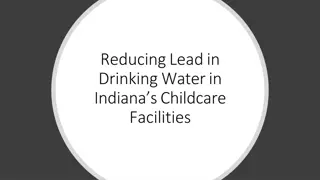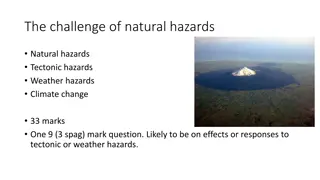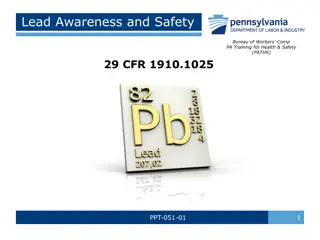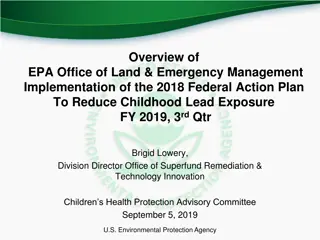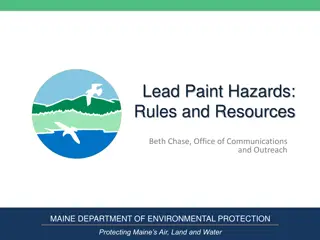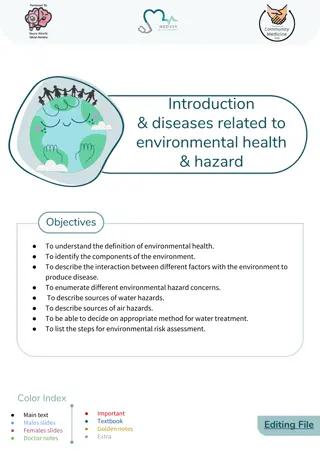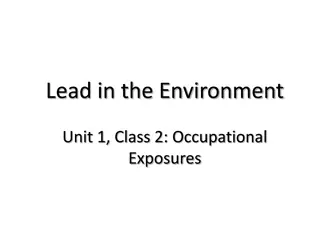Understanding Lead Exposure and Environmental Hazards
Lead, a soft metal abundant in the environment, has been used for various purposes throughout history. Exposure to lead can lead to serious health issues, especially in children. The impact of lead on public health and the environment, including its presence in gasoline and its effects on human health, is a concerning issue addressed by organizations like the CDC. Environmental hazards, such as lead contamination, pose risks to communities and can result in health disparities. Efforts to address and regulate lead exposure are essential for protecting public health.
Download Presentation

Please find below an Image/Link to download the presentation.
The content on the website is provided AS IS for your information and personal use only. It may not be sold, licensed, or shared on other websites without obtaining consent from the author. Download presentation by click this link. If you encounter any issues during the download, it is possible that the publisher has removed the file from their server.
E N D
Presentation Transcript
chemical reaction between a metal and its environment that causes it to break down into ions Word Bank Blood lead level difference in health outcome linked with economic, social, or environmental disadvantage Corrosion science of protecting and improving the health of people and their communities Environmental hazard amount of lead in blood, measured in micrograms per deciliter ( g/dL) of blood Health disparity substance, state, or event which has the potential to adversely affect people's health ppb Public health measure of concentration equal to the mass units of a substance per billion mass units in a sample Service line water pipe that directly connects a larger water main to individual buildings
Lead is a soft metal that is easy to work with and abundant in the environment Used throughout recorded history for weapons, medicines, makeup, coins, flavorings, metalwork, and other uses Lead poisoning can occur when lead is ingested, touched, or inhaled Lead poisoning causes learning disabilities, behavioral problems, and, at high enough levels, can cause seizures, comas, or death Damage occurs before symptoms do; early detection is key No safe level of lead in children has been identified Blood lead levels above 3.5 g/dL require medical intervention Understanding Lead
1. What are some common reasons that environmental hazards are not addressed? 2. What kind of work do you think CDC s National Center for Environmental Health (NCEH) does to address environmental hazards? Think About It 3. Give two examples of health disparities that might result from environmental hazards.
Lead in Gasoline Lead was added to gasoline in 1923 to stop engine knock Lead was released into atmosphere through car exhaust, where it was inhaled, deposited onto soil, and washed into water sources In 1970, the Environmental Protection Agency (EPA) was established and began to regulate lead CDC provided critical blood lead level data from the National Health and Nutrition Examination Survey (NHANES) to convince Congress to regulate lead in gasoline by demonstrating that less lead in gasoline was directly tied to decreasing blood lead levels Lead and CDC
Lead in Paint Lead has been used in paint for thousands of years Until the 1940s, paint in the U.S. was about 50% lead In the 1960s, citizens demanded safer housing for children, who often lick or eat peeling paint chips CDC began coordinating federal lead-poisoning programs in the 1970s and helped support regulations to remove lead from paint Childhood Blood Lead Surveillance System began in the 1990s to monitor children s lead levels Lead and CDC
Lead from Mining In 2010, CDC and other public health organizations travelled to Zamfara State in Nigeria to investigate an outbreak in children Symptoms in children included vomiting, abdominal pains, headaches, seizures, and death The team observed that many were bringing rocks into homes to mine for gold, thus spreading lead around their homes and village Safer mining practices were introduced, and contaminated soil was removed Lead and CDC
Other Sources of Lead Industrial contamination from workers who wear contaminated clothes home from work Corrosion of lead pipes in older water systems Soil contamination from prior lead exposure due to paint, gasoline, or other spills Imported toys and candies from countries with less strict lead regulations Lead and CDC
1. Why do you think lead poisoning is a health disparity linked to socioeconomic factors? 2. How was NHANES data useful in supporting the ban of lead from gasoline and fuel? Think About It 3. Why did the Zamfara team educate the villagers rather than shut down the mine?
From the Expert https://youtu.be/XVMZCqCpYCQ
1. It took 18 months for the people of Flint, Michigan to convince others that their drinking water was unsafe. Why might this be an example of a health disparity? 2. Elevated lead levels can affect learning, ability to pay attention, and academic achievement in children. How can these symptoms lead to inequality? Think About It 3. After examining the NCEH website, what environmental health topics surprised you? Why do you think these areas are considered part of public health?
Call to Action! 1. Examine historical lead data 2. Develop a plan to address a public health emergency. Give it a 3. Share your findings. Try Why do you think participation is important?
Surveillance Surveillance What is the problem? What is the problem? Risk Factor Identification Risk Factor Identification What is the cause? What is the cause? Use the Public Health Approach Intervention Intervention What works? What works? Implementation Implementation How did we do it? How did we do it?
1. Examine Historical Lead Data - Use data from the National Health and Nutrition Examination Survey (NHANES) to observe changes in blood lead levels over time - Data Set 1: Blood lead levels 1976-1980 - Data Set 2: Blood lead levels 1999-2016 - Look for health disparities in the data and develop a plan to address one of them Give it a Try
2. Develop a Plan to Address a Public Health Emergency - Read the timeline of the 2014-2016 Flint, Michigan water crisis, where 99,000 residents were exposed to unsafe tap water with high lead levels Choose a group that was affected by this crisis Design an intervention and develop an implementation plan for it Give it a Try - -
3. Share Your Findings - Instagram @CDCmuseum Give it a Try





